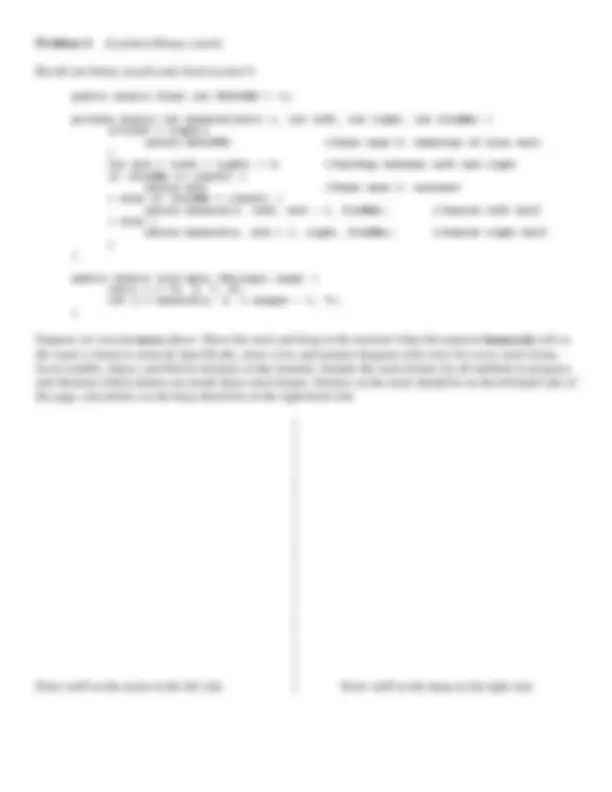




Study with the several resources on Docsity

Earn points by helping other students or get them with a premium plan


Prepare for your exams
Study with the several resources on Docsity

Earn points to download
Earn points by helping other students or get them with a premium plan
Community
Ask the community for help and clear up your study doubts
Discover the best universities in your country according to Docsity users
Free resources
Download our free guides on studying techniques, anxiety management strategies, and thesis advice from Docsity tutors
Solutions to problem 1 and problem 2 from the cs61b midterm 1 exam held in spring 2005. The problems cover topics such as instance variables, immutability, static methods, inheritance, and method overriding.
Typology: Exams
1 / 4

This page cannot be seen from the preview
Don't miss anything!



CS61B Midterm 1 Spring 2005 Professor Shewchuk Name_________________
Problem 1. (4 points) Quickies a. (1 point) Why is it usually better to declare an instance variable protected than to declare it private?
b. (1 point) Are Circle objects (defined in full below) immutable? Why?
public class Circle{ private double radius;
public Circle(double r){ radius = r; }
public double area(){ final double PI = 3.1415926535897; return (2.0 * PI * radius * radius); } }
c. (1 point) In a static method, you can never use the keyword ______________.
d. (1 point) In the following list, circle the types of statements that Java’s continue statement can potentially jump back to the beginning of.
for switch if while class do case
Problem 2. (8 points) Inheritance.
public class A{ public A(){ System.out.println(“New A”); }
public A(int x) {}
public void method1() { System.out.println(“M1 in A”); }
public void method2(){ System.out.println(“M2 in “ + whichClass()); }
public String whichClass() { return “A”; } }
public interface B { public void method2(); }
public class C extends A implements B{ public C(){ System.out.println(“New C”); }
public C(int x){ super(x); }
public void method1() { System.out.println(“M1 in C”); }
public void method3() { super.method1(); }
public String whichClass() { return “C”; } }
What does each of the following code fragments print? If a code fragment causes an error, say whether it is a compile-time error or a run-time error. If a code fragment prints nothing and causes no error, say so.
a. A a = new C(3); a.method1();
b. B b = new C(5); b.method2();
c. C c = (C) new A(4); c.method1();
d. B b = new C(8); System.out.println(b.whichClass());
e. B b = new C(); ( (A) b).method1();
f. (new C(5) ).method3();
g. B b = new B(); b.method2();
Problem 4. (7 points) Reordering a Singly-Linked List.
Write a method called reorder in the SList class below. reorder changes the order of nodes in a singly- linked list. Upon completion, the nodes in the list appear in the following order: the former first node, the former third node, the former fifth node, followed by the remaining former odd-numbered nodes. Then comes the former second node, the former fourth node, and so on. For example, [ This is a list of coherent Strings ] becomes [ This a of Strings is list coherent ]. Your solution should manipulate next pointers directly. Do not call any method of SList provided in this course. Do not change any item references of create any new nodes.
public class SListNode{ public Object item; public SListNode next; }
public class SList{ private SListNode head; private int size;
public void reorder(){
} }